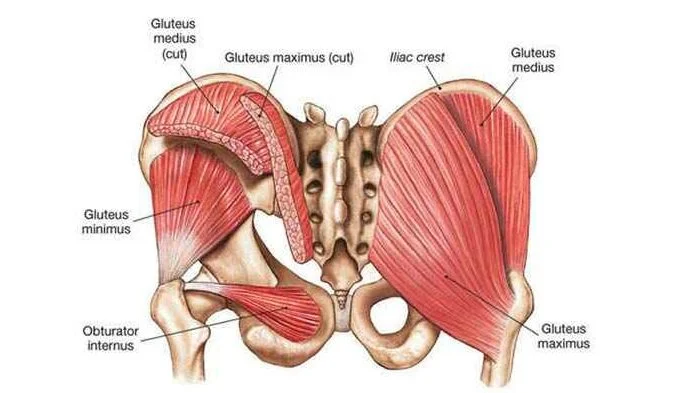Muscles of the Gluteal Region
The muscles of the gluteal region can be described as superficial and deep:
Superficial muscles include the following:
Gluteus maximus
This muscle originates on the sacrum, coccyx, and ilium, posterior to the posterior gluteal line and attaches to the gluteal tuberosity and iliotibial tract
This muscle acts to extend both the hip and knee joints
Gluteus medius
This muscle originates on the external ilium between the anterior and posterior gluteal line and attaches to the greater trochanter
This muscle acts to abduct and medially rotate at the hip joint
Gluteus minimus
This muscle originates on the external ilium between the anterior and inferior gluteal line and attaches to the greater trochanter
This muscle acts to abduct and medially rotate at the hip joint
Tensor fascia lata
This muscle originates on the iliac crest and attaches to the iliotibial tract
This muscle acts to extend at the knee joint
Deep muscles include the following:
Piriformis
This muscle originates on the anterior sacrum and attaches to the trochanteric fossa and medial side of the greater trochanter
This muscle acts to laterally rotate and abduct at the hip joint
Obturator internus
This muscle originates on the obturator membrane and attaches to the trochanteric fossa and medial side of the greater trochanter
This muscle acts to laterally rotate and abduct at the hip joint
Gemellus superior
This muscle originates on the ischial spine and attaches to the trochanteric fossa and medial side of the greater trochanter
This muscle acts to laterally rotate and abduct at the hip joint
Gemellus inferior
This muscle originates on the ischial spine and attaches to the trochanteric fossa and medial side of the greater trochanter
This muscle acts to laterally rotate and abduct at the hip joint
Quadratus femoris
This muscle originates on the ischial tuberosity and attaches to the intertrochanteric crest
This muscle acts to laterally rotate at the hip joint
Clinical Notes:
Weakness of the gluteus medius and gluteus minimus muscles or an injury to the superior gluteal nerve results in gluteal gait. In gluteal gait the body leans towards its weakened side to place it’s center of gravity over supporting limb. A positive Trendelenburg test is when the individual is standing on one leg and the pelvis on the unsupported side descends.
The gluteus maximus is used at the region for intramuscular injections.

